Maintaining a clean and clear pool is essential for a refreshing and relaxing swimming experience. However, all pools are different and require their own TLC to keep them in top shape. Whether you have a pool in sunny Tampa, FL, chilly Rochester, NY, or bustling Virginia Beach, the climate, environment, and usage patterns can all affect the cleaning and maintenance needs of your pool. In this article, we will explore the different factors that can impact pool cleaning, and provide tips and recommendations for maintaining a clean and clear pool, including how to clean a pool without chemicals, no matter where you are located.
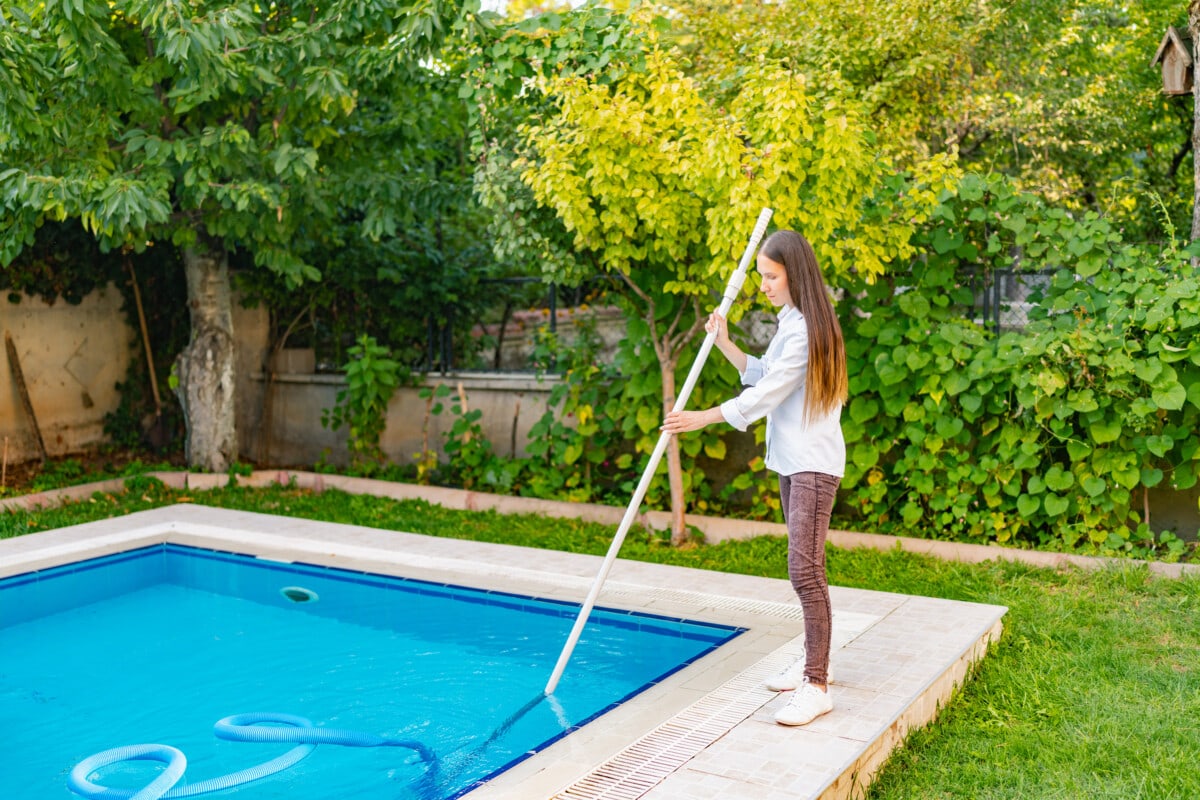
Tools needed to clean a pool
Cleaning a pool requires a variety of tools to keep the water clean and clear. Here are some tools that are essential for pool cleaning:
- Skimmer Net: A skimmer net is used to remove leaves, bugs, and other debris from the surface of the water.
- Pool Brush: A pool brush is used to scrub the walls and floor of the pool to remove algae and other buildup.
- Pool Vacuum: A pool vacuum is used to remove debris and dirt that has settled on the bottom of the pool.
- Test Kit: A pool test kit is used to test the pH, alkalinity, and chlorine levels in the water.
- Chemicals: Pool chemicals such as chlorine, pH adjusters, and algaecides are used to maintain proper chemical balance and prevent algae growth.
- Pool Filter: A pool filter is used to remove small particles and impurities from the water.
- Telescopic Pole: A telescopic pole is used to attach pool cleaning tools, such as the skimmer net and pool brush, and to reach different areas of the pool.
- Pool Cover: A pool cover can be used to keep debris out of the pool when it is not in use.
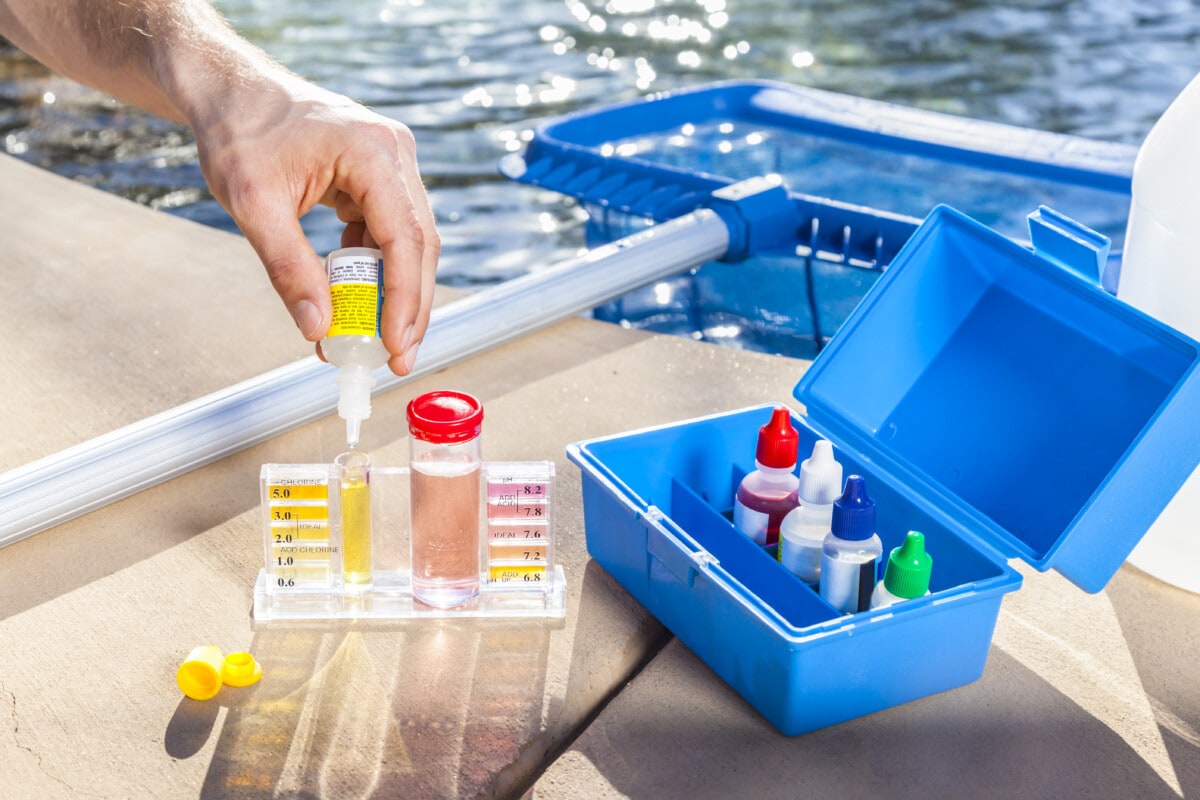
Renovating your home?
Find out what your home's worth, edit facts, and see the impact of home projects.
Crystal clear waters: A step-by-step guide to cleaning your backyard pool
Renovating your home?
Having a pool in your backyard can be a great source of fun and relaxation during the hot summer months. However, to keep your pool looking and functioning its best, regular maintenance and cleaning are necessary. “Pool ownership can be an exciting and rewarding experience, but it also requires a certain level of maintenance to ensure that the pool remains clean, safe, and inviting for family and friends,” shares Innovative Spas. “There are three main aspects of pool maintenance that new pool owners should master: circulation, cleaning, and chemistry.”
Here’s a step-by-step guide to cleaning your residential pool:
Step 1: Skim the surface
Using a pool skimmer net, remove any leaves, insects, or other debris from the surface of the water. This is an essential step as debris left floating in the pool can eventually sink to the bottom, making it more difficult to clean. “Regular cleaning through brushing, skimming, and vacuuming will also help keep the water sparkling,” says Innovative Spas.
Step 2: Brush the walls
Using a pool brush to scrub the walls and floor of the pool to remove any algae or dirt buildup. Pay extra attention to areas that are shaded or not well-circulated, as these areas are more prone to algae growth.
When it comes to brushing your pool, the type of material your pool surface is made of will determine the type of brush you should use. Different pool surfaces require different types of brushes for effective cleaning. For example,
- If your pool surface is unpainted concrete, you should use a brush with both stainless steel and nylon bristles.
- For a gunite pool, a brush with stainless steel bristles is recommended.
- For fiberglass, vinyl, or painted concrete surfaces, it is best to use a brush with nylon bristles only.
Choosing the right brush for your pool surface is important to effectively remove debris, algae, and other buildup for a clean and clear pool.
Step 3: Vacuum the pool
After brushing, use a pool vacuum to remove any debris or dirt that has settled on the bottom of the pool. If your pool has a built-in vacuum system, follow the manufacturer’s instructions to use it. If not, you can use a manual vacuum or a handheld pool vacuum that attaches to your pool’s filter system.
When it comes to vacuuming your pool, you have two options: manual or automatic. A manual pool vacuum requires more effort and time to clean the entire pool, while an automatic pool vacuum does the work for you by moving around the pool and cleaning the surfaces. Both options can be effective, but the choice ultimately comes down to personal preference and budget. Automatic pool vacuums tend to be more expensive, but they save time and energy, while manual pool vacuums are more affordable and give you more control over the cleaning process. Ultimately, it is best to choose the option that works best for you and your specific pool cleaning needs.
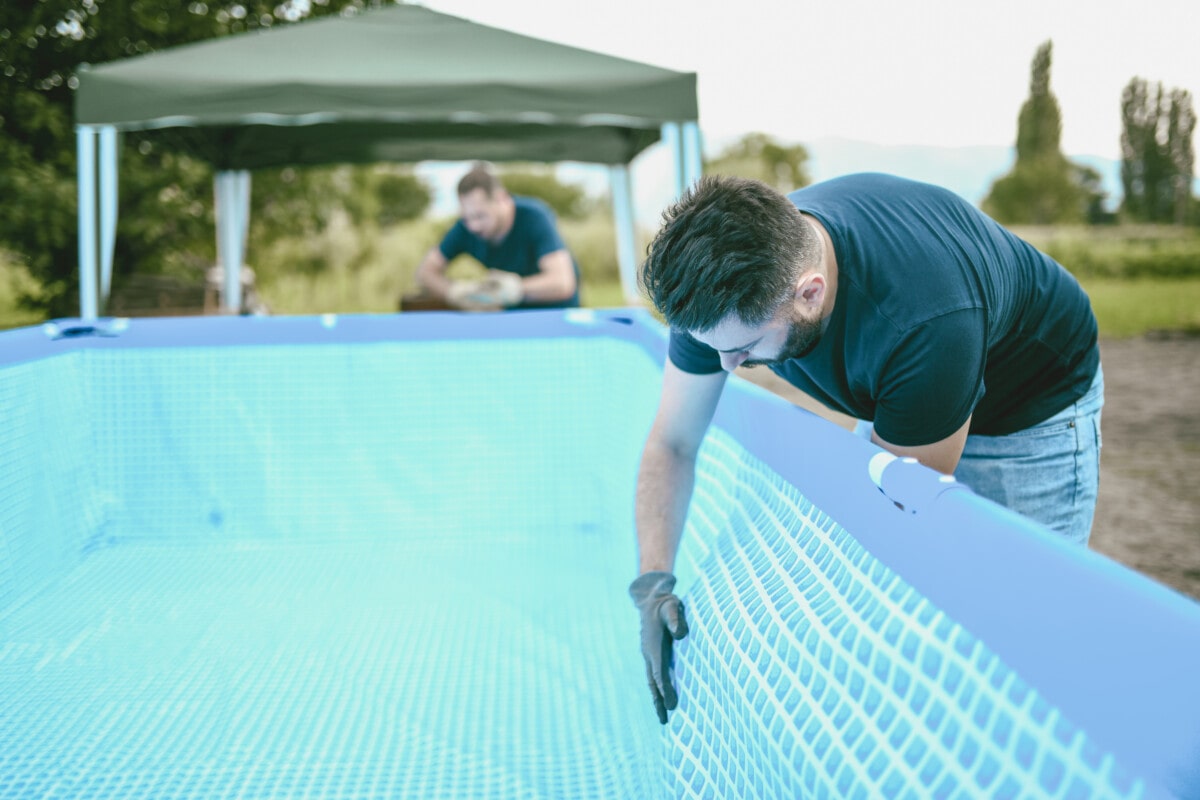
Step 4: Check the filter
Your pool’s filter plays a crucial role in keeping your pool clean by removing small particles from the water. Check your filter regularly and clean or replace it as needed. Some filters can be hosed off or backwashed to remove debris, while others need to be replaced entirely.
Make sure to check your pool’s skimmer basket as part of the pool filtration system to prevent algae build up in your pool. “It’s essential to keep the skimmer basket free of debris to maintain a clean and healthy swimming pool,” recommends Sidekick Pool Repair in Columbia. “When the skimmer basket gets clogged, water flow is restricted, which reduces filtration and circulation and can lead to stagnant water and algae growth. To prevent algae growth, clogs, and reduced circulation, it’s important to empty the skimmer basket at least once a week.”
How to carefully clean your pool filter
- Turn off the pool pump: Before beginning the cleaning process, make sure to turn off the pool pump to avoid any accidents or damage to the filter system.
- Remove the filter: Depending on the type of filter you have, the process for removing it will vary. In general, the filter can be removed by turning the valve handle to the “off” position and unscrewing the filter housing. If you are unsure about how to remove your specific filter, refer to the manufacturer’s instructions.
- Clean the filter: Once the filter is removed, you can begin cleaning it. Start by hosing off any loose debris or dirt from the filter element or cartridges. If the filter is heavily clogged with debris, you may need to soak it in a cleaning solution overnight. Use a filter cleaner specifically designed for your type of filter, and follow the manufacturer’s instructions carefully.
- Rinse the filter: After cleaning the filter, rinse it thoroughly with a hose or pressure washer to remove any remaining debris or cleaning solution. Make sure to rinse both the inside and outside of the filter element or cartridges.
- Reassemble the filter: Once the filter is clean and rinsed, it can be reassembled. Make sure to replace any o-rings or gaskets that may have become worn or damaged.
- Restart the pump: After the filter is reassembled, turn on the pool pump and check for any leaks or abnormalities. Allow the pump to run for a few minutes to make sure the water is flowing properly.
Step 5: Check the chemical levels
Proper chemical balance is essential for keeping your pool clean and safe to swim in. Use a pool testing kit to check the levels of chlorine, pH, and alkalinity in the water. Adjust the levels as needed using pool chemicals. “Water chemistry is key to maintaining crystal-clear water that is safe for swimming, and weekly testing and balancing is essential,” recommends Innovative Spas. “While chemistry may seem intimidating, with a little practice and a good plan, it can be mastered. Being proactive with weekly treatments such as chlorine shock, algaecide, and enzymes can save money, prevent stress, and ensure balanced water for enjoyable pool parties. By dedicating just a few minutes each week, pool owners can enjoy days of quality time in the pool with loved ones.”
Tips on how to check your pool’s chemical levels with a pool testing kit
- Test at the Right Time: Test your pool’s chemical levels at least once a week.
- Collect Water Samples: Use a clean container to collect water samples from different areas of the pool, including the deep end, shallow end, and middle. Mix the samples together in the container.
- Test for pH: Test the pH level of the water using pH testing strips or liquid. The ideal pH level for a pool is between 7.2 and 7.8.
- Test for Alkalinity: Test the alkalinity of the water using alkalinity testing strips or liquid. The ideal alkalinity level for a pool is between 80 and 120 ppm.
- Test for Chlorine: Test the chlorine level of the water using chlorine testing strips or liquid. The ideal chlorine level for a pool is between 1 and 3 ppm.
- Adjust the Chemical Levels: If the chemical levels in your pool are too high or too low, adjust them accordingly using pool chemicals. Follow the manufacturer’s instructions carefully and retest the water after a few hours to ensure the chemical levels have been properly balanced.
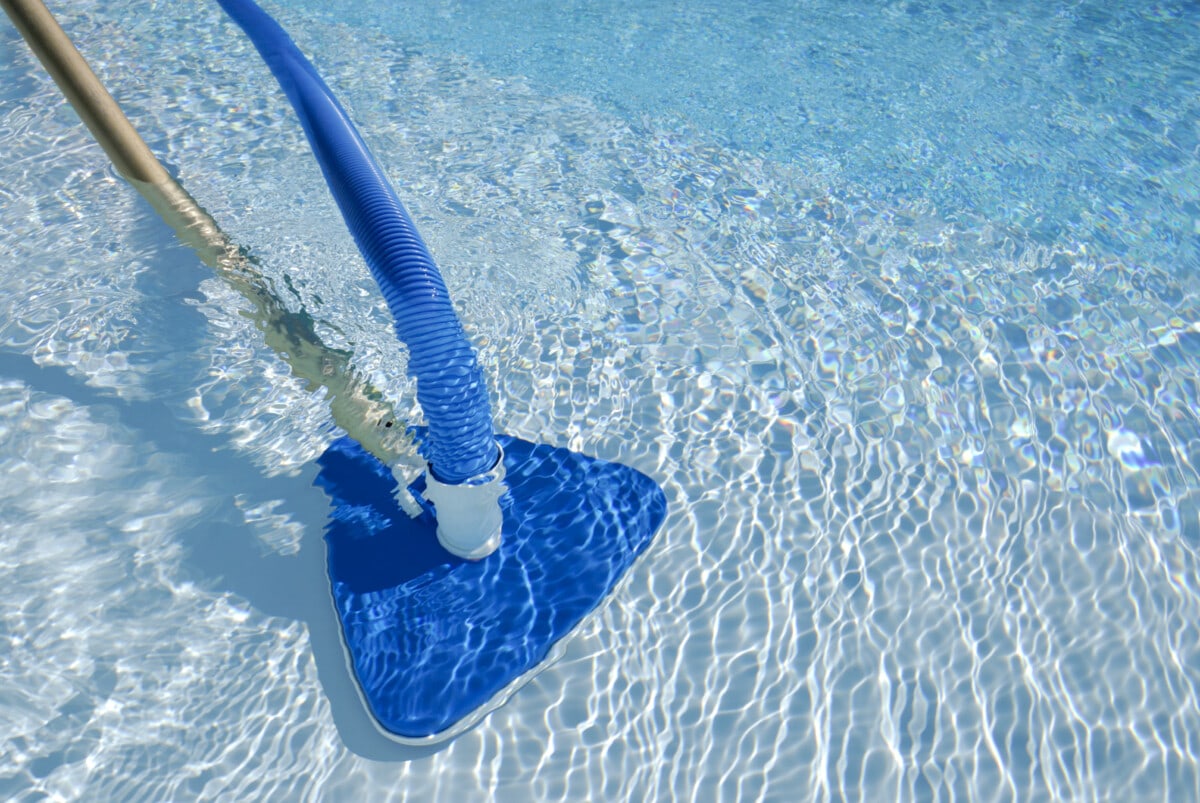
Step 6: Shock the pool
Occasionally, your pool may need a “shock” treatment to remove bacteria or algae that may be resistant to regular chlorine treatments. Follow the instructions on a shock treatment product of your choosing carefully, as different products may require different amounts or procedures.
Step 7: Regular maintenance
Cleaning your pool is not a one-time job. To keep your pool in top condition, you should maintain a regular cleaning and maintenance schedule. Skim the surface and brush the walls of the pool at least once a week, vacuum the pool as needed, and check and adjust the chemical levels regularly.
Tips on how to maintain a clean pool
- Skim the surface of the pool regularly to remove debris.
- Run the pool pump and filter system for at least 8 hours a day.
- Cover the pool when not in use to prevent debris from falling in.
- Shower before swimming to prevent oils and lotions from entering the pool.
- Brush your pool if you start to see algae growth.
- Check your pool’s chemical balance and pH after heavy uses to prevent cloudy water.
Step 8: Don’t forget to clean your pool deck
Clean the pool deck regularly to prevent debris, dirt, and algae from entering the pool, which can clog the filter, create cloudy water, and contribute to algae growth. Additionally, a clean pool deck can help prevent slips and falls, making your pool area safer for everyone.
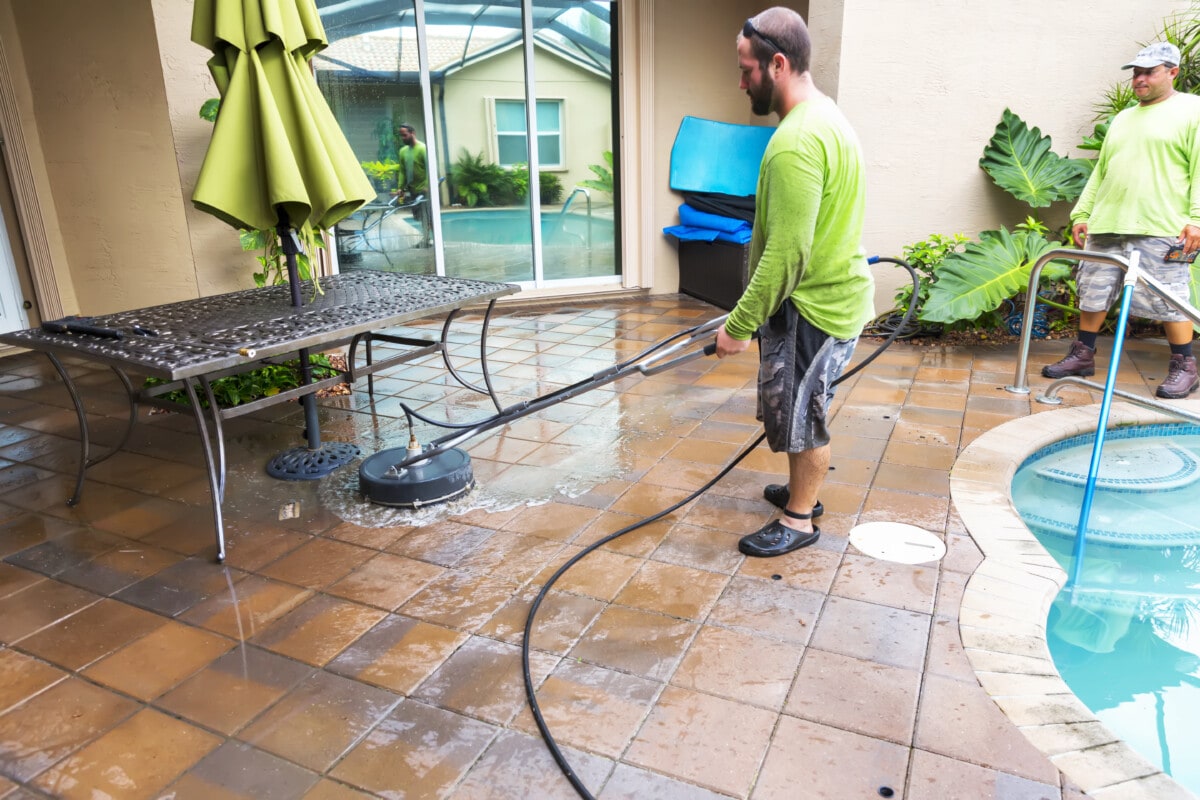
How to clean a pool without chemicals
While chemicals are commonly used to clean and clear a pool, it is possible to maintain a pool without them. However, it’s important to note that this method requires more effort and diligence, and it may not be as effective as using chemicals. Here are some alternative methods for cleaning and clearing a pool without chemicals:
Skim and brush regularly
The most important step in maintaining a pool without chemicals is to skim the surface and brush the walls and floor regularly to remove debris and prevent algae growth.
Use a natural filtration system
A natural filtration system such as a biofilter or a wetland filter can be used to remove impurities and maintain water quality without the use of chemicals. These systems work by using plants and natural bacteria to filter the water.
Use ultraviolet (UV) light
UV light can be used to kill bacteria and other microorganisms in the water, which can help maintain water quality without chemicals. However, this method is not as effective as using chemicals for clearing up algae.
Use an Ozone Generator
An ozone generator can be used to oxidize and remove impurities from the water, which can help maintain water quality without chemicals. However, this method is also not as effective as using chemicals for clearing up algae.
Maintain proper water balance
Maintaining proper water balance, including pH, alkalinity, and calcium hardness, is essential for keeping a pool clean without chemicals. Improper water balance can lead to algae growth and other problems.

Looking to save money on your mortgage?
Answers to Your Top Pool Cleaning FAQs
How much is pool cleaning service?
The cost of professional pool cleaning can vary depending on several factors, including the size of the pool, frequency of cleaning, location, and additional services needed. On average, professional pool cleaning can cost anywhere from $75 to $200 per visit.
How often should I clean my pool?
It’s recommended to clean your pool once a week, including skimming the surface, brushing the walls and floor, vacuuming the pool, and checking the chemical levels.
How often should I backwash my pool filter?
It’s recommended to backwash your pool filter once a month or when the filter pressure increases by 8-10 pounds per square inch (psi) above the normal operating pressure.
How do I clean my pool cover?
Use a pool cover cleaner or a mixture of mild soap and water to clean the cover. Rinse thoroughly and allow to dry before storing.
How do I winterize my pool?
Lower the water level, clean and drain the pool equipment, add winterizing chemicals, and cover the pool to prevent debris from falling in.
How do I troubleshoot problems with my pool equipment?
Refer to the owner’s manual for troubleshooting tips, or contact a pool professional for assistance.
How do I troubleshoot a pool leak?
Check for obvious signs of a leak, such as a drop in water level, and inspect the pool equipment, pipes, and fittings for damage or wear. If the leak is not obvious, contact a pool professional for assistance.
How do I remove stains from my pool?
The type of stain will determine the treatment method. For example, a metal stain can be treated with a metal sequestering agent, while an organic stain can be treated with an enzyme-based cleaner.



























 United States
United States Canada
Canada